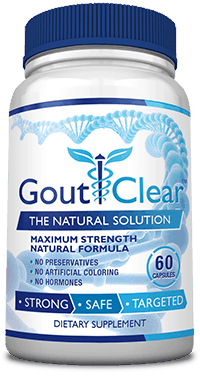Information on Gout

According to the U.S. Census Bureau, in 2005 alone, an estimated 3 million adults were diagnosed with gout and overall there were 6.1 million reported cases of gout. Statistics show that cases of gout are increasing at an alarming rate. Gout is now becoming one of the major causes of disability in our society.
However, with good disease management, gout can be controlled. A significant number of cases are "treatment failure gout", meaning adequate control of symptoms is not achieved and the disease progresses. According to recent studies, a large number of patients undergo medical treatment but are insufficiently managed. There are an estimated 100,000 to 300,000 cases of "treatment-failure gout" in the U.S alone. Because of this, there is an increase in people turning to natural and alternative treatments to relieve the pain of gout.
What is Gout?

Gout is a form of arthritis, also known as, gouty arthritis. It is more common in middle aged men, the obese and less common in women and children. Gout is 9 times more common in men than women, but usually affects women around the time of menopause. The pain of gout is caused by sharp uric acid crystals forming in the joints and soft tissue near the bones. These crystals rub up against the tissue and cause inflammation and swelling. For most healthy individuals, the kidneys break down excess uric acid and eliminate it from the body. The onset of gout is extreme and sudden pain, usually in the big toe and moving to other joints.
Gout can lead to complications such as; extreme joint pain, loss of range of motion, trouble walking, deformities and kidney stones. The combination of excess uric acid and heart disease can lead to heart attacks. There is also a connection between gout and dry eyes, lung disease, cataracts and spinal stenosis.
Gout Causes

The cause of gout has a few different factors involved. Gout has about a 40 to 80 percent genetic component; therefore, if you have a parent with gout you are likely to get the disease. Other factors are obesity, alcohol use, drug use and eating a diet high in purine foods. High purine foods are organ meats, cured meats, smoked fish and certain types of alcohol. Gout can be triggered by other health conditions such as; kidney disease, trauma and surgery. Click here to see the full study.
What are the Symptoms of Gout?

Symptoms of gout begin suddenly and usually in the big toe. It then spreads to other joints quickly. It can come on with no warning and it is very painful. Chances are, by the time symptoms appear the disease has already progressed to the acute stage. The four stages of gout are:
Asymptomatic Stage – This is the first stage of gout and at this time there are little or no symptoms. Uric acid levels are rising in the bloodstream and beginning to form crystals. This time is critical because of the damage that can occur to the joints at this stage without the person knowing.
Acute Stage – This is the onset of gout symptoms and lasts 5-10 days. The pain comes on suddenly in the big toe and can spread to other joints. There may be fever, inflammation and redness in the joints. Also, deformities can occur and the sufferer is unable to wear their regular fitting shoes.
Inter-Critical Stage – This is a type of "honeymoon phase" where sufferers are symptom free. This phase can last from 3-10 years. During this time the uric acid levels can still rise in the bloodstream and cause damage. It is important to continue treatment through this phase as a prophylactic measure.
Chronic Stage – This is when the disease becomes chronic and intermittent "flares" of joint pain appear and nodules called "tophi" can appear near joints and in the earlobes. The uric acid levels are very high and can cause other health issues such as hypertension and kidney disease.
If gout is found and treated early, the symptoms will be manageable. As many as 70 percent of gout sufferers have reported that delaying treatment led to irreversible deformities in the feet. The only issue is that during the asymptomatic stage, there are usually no symptoms and by the time the acute stage appears, there is already damage to the joints. Also, gout pain may manifest itself like regular arthritis and be misdiagnosed.
How to Treat Gout?
 Alternative treatment for gout pain is becoming increasingly popular. Here are some helpful tips for gout pain:
Alternative treatment for gout pain is becoming increasingly popular. Here are some helpful tips for gout pain:
- Keep the affected body part elevated.
- Get plenty of exercise when you feel well, rest the affected area when you have pain.
- Drink plenty of non sugary fluids. This will help dilute the uric acid in your body and can help prevent kidney stones. Kidney stones are a side effect of excess uric acid in the blood.
- Keep your weight at a healthy level. Excess weight can only complicate things further and puts too much strain on fragile joints.
- Find a new beverage other than beer. Beer is high in purines and raises uric acid levels. White wine does not appear to complicate gout, but red wine is also high in purines.
- Eat a diet low in purines and increase natural anti-inflammatory foods such as; cherries, berries and apples. A handful of cherries a day has been shown to be very helpful. But the best is Tart Cherry juice, extract or fruit.
- Beef, lamb and pork, organ meats and lunch meats.
- Hot-dogs, salami and cured meats.
- Canned tuna and smoked fish and herring.
- Shellfish (shrimp, crab, scallops, mussels, clams) sardines and anchovies.
- Some fish-Cod, trout and haddock.
- Beer, red wine, grain liquor and regular soft drinks.
- Asparagus,spinach,cauliflower and mushrooms.
- Dried beans or legumes, green peas and lentils.
- Oatmeal.
Many physicians are prescribing powerful medications to control gout symptoms. These medications can have side effects such as vomiting, diarrhea, nausea, hair loss and certain types of anemia. The good news is there are alternative therapies that can help control gout. Alternative therapies are all natural and easily obtained. The cost is lower than prescription medications and they have few or no side effects.
Living with gout does not have to be debilitating. But it takes a few healthy lifestyle changes for gout sufferers to be back to normal. There are alternative therapies for managing gout and studies have shown them to be very helpful. Alternative treatments for gout can be of great help in alleviating symptoms and help sufferers achieve a better quality of life.







 GoutClear™'s formulation of effective ingredients and strong name recognition have brought praise from both customers and health professionals alike. To learn more about the research and data behind GoutClear™ , please visit our "
GoutClear™'s formulation of effective ingredients and strong name recognition have brought praise from both customers and health professionals alike. To learn more about the research and data behind GoutClear™ , please visit our "




